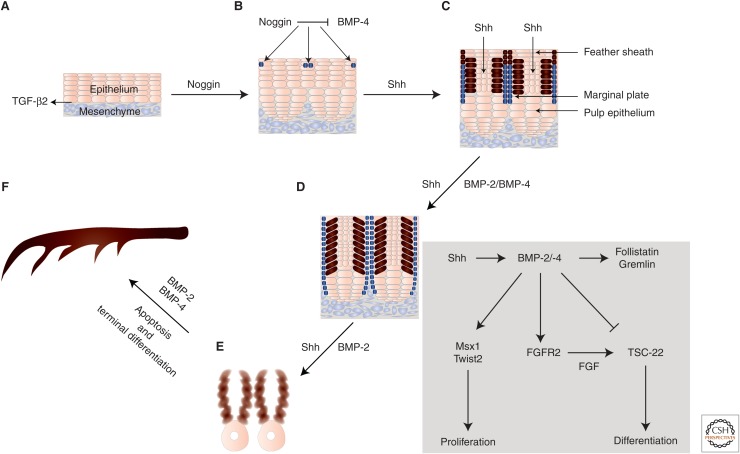Figure 2.
Branching and evolution of feathers. (A,B) TGF-β2 localizes in the border where epithelium and mesenchyme interact. The multilayered epidermis can be divided into epidermal ridges (dark blue cells) by the ridge-forming activator noggin and the ridge-forming inhibitor BMP-4. Noggin and BMP-4 are distributed in the mesenchyme (not shown) and their balanced action is crucial for normal specification of these primordial ridge cells. (B,C) High BMP-4 levels at the proliferative zone lead to the formation of a cylindrical structure by the epithelial cells. Within the epidermis, when the level of noggin is high, the epithelia gradually start to form multiple barb ridges (blue cells). The role and localization of the upstream Sonic Hedgehog (Shh) is also indicated. (D) Expression of BMP-2 and BMP-4 is regulated by Shh signaling. Bone morphogenetic proteins (BMPs) mediate a lateral inhibitory mechanism that leads to arrangement of feather buds in a periodic pattern. BMP signaling in the feather bud cells (brown) regulates the expression of FGFR2. Moreover, BMP induces the expression of transcriptional regulators Msx1 and Twist2 that drive feather bud proliferation. Follistatin and gremlin, secreted by feather interbud dermal cells moderate the autocrine action of BMP signaling via a feedback mechanism. TSC-22 expression is repressed by BMP signaling and induced by FGF signaling, and is required for feather cell differentiation. Marginal plate cells that express Shh and BMP-2 undergo apoptosis, and Shh-negative barb ridge cells continue proliferating. (E,F) Barb ridge cells express BMP-2 and BMP-4 and form the more differentiated structures known as barbules. Barbule plate cells form cilia and hooklets. Noggin activity toward the end of feather formation is reduced and leads to formation of the calamus without branches at the proximal end of the feather shaft. The site with higher BMP activity forms the bilateral symmetric feather. (The image has been inspired by the article of Yu et al. 2002.)

